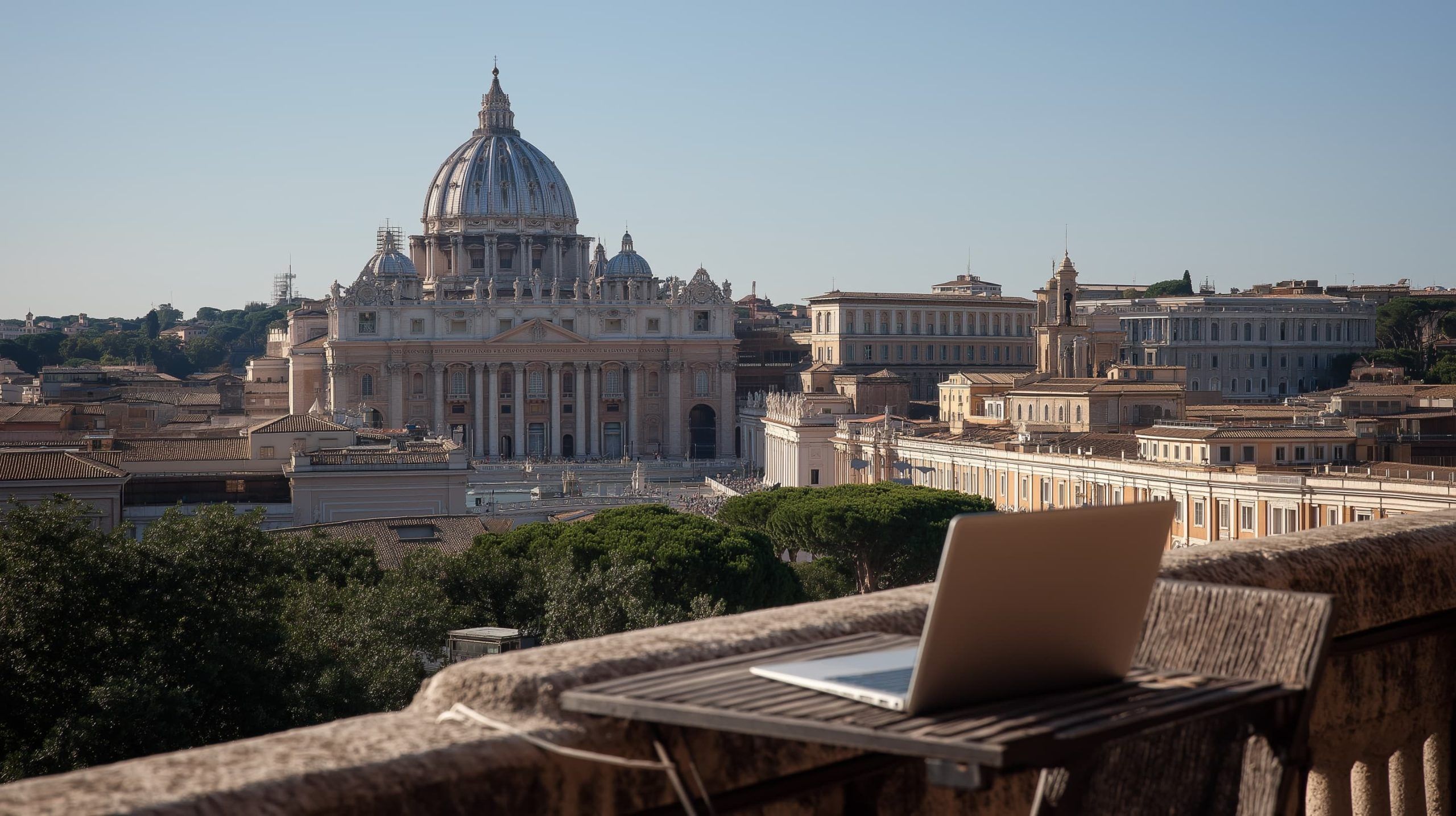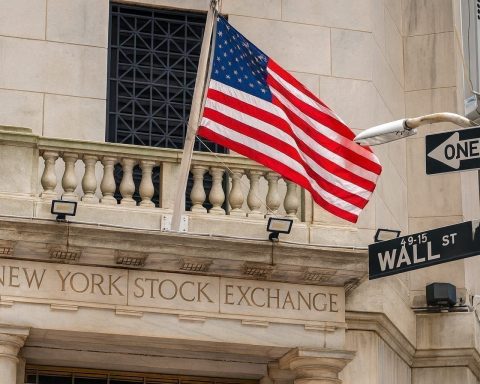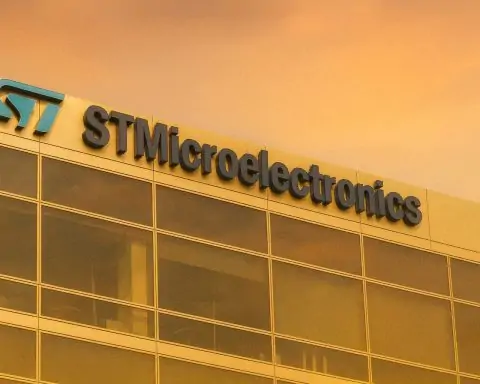- The Holy See published its first website, www.vatican.va, on December 25, 1995, marking Vatican City’s online debut and the creation of the Vatican Internet Service.
- By the late 1990s the Vatican established the Internet Office of the Holy See as its ISP, connected Vatican City to the global internet, and secured the .va domain for the state.
- In 2010 a contract with Telecom Italia deployed a fiber-optic network linking Vatican sites and extraterritorial properties such as Castel Gandolfo and the Vatican Radio transmission center.
- By 2020 about 5,000 Vatican telephone lines were connected through an IMS digital exchange, with fiber links providing data and voice to Italian operators and international carriers.
- Vatican City does not run its own mobile network; it is served by Italian operators TIM, Vodafone, WindTre, and Iliad, with 4G coverage essentially ubiquitous and 5G availability in urban Rome by the mid-2020s, with end-user speeds in the tens to hundreds of Mbps.
- Public internet access inside Vatican City is minimal, with no public Wi‑Fi in Vatican Museums and visitors relying on Italian networks, and the 2013 conclave illustrating a temporary signal jamming security measure.
- The Vatican uses satellite as a backup and for broadcasting, with providers including GlobalTT, Hughes, Viasat, and Syntelix, and with OneWeb and Starlink offerings up to about 200 Mbps.
- The Vatican operates its own internal ISP via the Directorate of Telecommunications and Information Systems, manages the .va domain and IP addresses, and peers with NaMeX and GARR while obtaining upstream transit mainly from Telecom Italia.
- Cybersecurity has evolved from high-profile incidents such as the 2015 Vatican Radio hacks and the 2022 Vatican.va DDoS to proactive defenses, including the 2022 Vatican Cyber Volunteers (about 90 members) and the 2025 creation of a Vatican CERT with an AI-driven defense partner.
- Digitization and digital services have grown, with the Vatican Library digitizing 40 million pages since 2010 and over 19,000 manuscripts scanned online by 2020 via DigiVatLib, plus the 2024 AI-driven St. Peter’s Basilica experience with Microsoft for reservations and virtual tours using 22 terabytes of data.
The Vatican City State, though the world’s smallest country, boasts a modern telecommunications system. It controls its own top-level internet domain .va and nearly all of its roughly 800 residents have internet access, with cellular phones widely used in daily life [1]. Over the past few decades, the Vatican has steadily embraced digital connectivity – from launching its first website in the 1990s to deploying fiber-optic broadband across its territory. This report provides a comprehensive overview of internet access in Vatican City, covering its historical development, current infrastructure (fiber, DSL, mobile, Wi-Fi, satellite), service providers and partnerships, coverage and performance, satellite services, institutional and public usage, regulatory and security measures, as well as challenges and ongoing digital initiatives.
Historical Development of Internet Access in Vatican City
Vatican City’s journey into the internet age began in the mid-1990s. A milestone was reached on December 25, 1995, when Pope John Paul II’s Christmas message was published on the Holy See’s first website, www.vatican.va, marking the Holy See’s debut online presence [2]. This event inaugurated the Vatican Internet Service, a dedicated office tasked with managing the Vatican’s online activities [3]. By the late 1990s, the Vatican formally established an “Internet Office of the Holy See” – effectively its own Internet Service Provider (ISP) – which connected Vatican City State to the global internet [4]. Along with this, the Vatican secured the “.va” country-code top-level domain and introduced electronic mail for its institutions [5].
Throughout the late 1990s and early 2000s, the Vatican expanded its network capabilities to keep pace with the burgeoning internet. The Great Jubilee of 2000 (a major event drawing millions of pilgrims) acted as a catalyst for infrastructure upgrades to handle increased online traffic and digital communications [6]. Early connectivity likely relied on leased lines or DSL connections through Italian providers, but demand for better speed and reliability grew. By 2010, Vatican City announced plans for a comprehensive fiber-optic network. A contract with Telecom Italia was signed to install fiber broadband linking all key Vatican sites, including not only the territory of Vatican City itself but also extraterritorial properties like the Pope’s summer residence at Castel Gandolfo and the Vatican Radio transmission center outside Rome [7]. This project marked Vatican City’s transition to high-speed broadband, capable of carrying voice, data, and video communications over a modern IP network.
In summary, from a single webpage in 1995 to a state-of-the-art fiber network by 2010, the Vatican’s internet access evolved rapidly. The Holy See’s proactive stance – encouraged by successive popes – ensured that the Church’s communication channels kept up with technology. By the 2010s, the Vatican had integrated internet connectivity deeply into its operations, setting the stage for the advanced services and infrastructure it enjoys today.
Current Infrastructure and Technologies
Fixed Broadband (Fiber-Optic and DSL): The backbone of Vatican City’s internet is now a fiber-optic network. The 2010 Telecom Italia partnership led to the deployment of fiber-optic cables throughout the enclave, providing broadband connectivity for data, voice, and video across all Vatican facilities [8]. This network extends beyond the Vatican’s walls to connect important satellite sites (like Castel Gandolfo and radio towers), ensuring that even off-site locations are integrated. Fiber-optic broadband delivers high speeds and low latency, a significant upgrade from earlier technologies such as DSL or older copper lines. Today, broadband service is widely available within Vatican City, with high-speed internet in offices, institutions, and residences [9]. While specific bandwidth figures are not published, fiber connectivity implies gigabit-class speeds can be achieved for institutional users. Prior to fiber, the Vatican likely utilized ISDN or DSL links via the Italian infrastructure, but those have largely been supplanted by the more robust fiber network. Notably, the Vatican’s internal telephone system has also been modernized to run on digital exchanges supported by fiber links. By 2020, about 5,000 telephone lines in Vatican City were connected through an IMS (IP Multimedia Subsystem) digital exchange, with fiber-optic links providing both phone and internet data connectivity to Italian operators and international carriers [10] [11]. This highlights how closely integrated the data and voice networks have become under the fiber infrastructure.
Mobile Networks (3G/4G/5G Coverage): Vatican City does not maintain its own mobile carrier network; instead, it is seamlessly served by the major Italian mobile operators. The enclave’s tiny size (0.44 km²) and location in the heart of Rome mean that cellular coverage from TIM, Vodafone, WindTre, and Iliad blankets Vatican territory. Visitors and residents use Italian SIM cards which “work greatly within” Vatican City, as the signals from nearby cell towers easily cover the area [12]. 4G LTE coverage is essentially ubiquitous, and as Italy rolled out 5G in urban centers (including Rome) starting in 2019, the Vatican City area also benefits. By the mid-2020s, 5G service from at least some operators is available; for example, Vodafone has been noted for particularly fast 5G speeds in Vatican City (as measured by crowdsourced signal reports) [13]. It should be noted that Vatican City coordinates its use of the radio spectrum with Italy to prevent interference, given the shared frequencies in such close proximity [14]. For end-users, mobile data speeds in the Vatican are on par with those in central Rome – often tens or hundreds of megabits per second on 4G/5G, depending on network conditions. Mobile connectivity is crucial not just for tourists but also for Vatican personnel who rely on smartphones for communication. The Vatican’s internal mobile communications are augmented by special arrangements to ensure coverage during papal travel; the Vatican’s system is designed to leverage satellite links if needed so that telecommunication services remain uninterrupted when the Pope is abroad [15]. In everyday practice, however, within Vatican City the terrestrial mobile networks suffice for reliable coverage and capacity.
Wi-Fi and Local Networks: Within many Vatican buildings (administrative offices, the library, museums, etc.), local Wi-Fi networks are used to provide internet access to staff and authorized guests. These internal Wi-Fi deployments ride on the robust wired infrastructure. However, when it comes to public Wi-Fi, Vatican City is quite restrictive. For security reasons, no public-facing Wi-Fi is offered in areas like the Vatican Museums [16]. Visitors touring the museums or St. Peter’s Basilica will not find official free Wi-Fi networks provided by the Vatican. In fact, the Vatican Museums explicitly state that Wi-Fi is unavailable and even discourage the use of mobile phones inside [17]. This policy is rooted in concerns over security and maintaining an atmosphere appropriate to sacred and cultural sites. Likewise, there are no public internet cafés or shared computer terminals in Vatican City open to tourists. The small resident population (clergy and staff) have their personal or office internet access already, so there is little need for public hotspots. It’s worth noting that during particularly sensitive events, such as a papal conclave, the Vatican takes the extraordinary step of shutting down or jamming wireless signals altogether. For example, at the 2013 conclave to elect Pope Francis, the Vatican deployed electronic jammers to block any outgoing or incoming signals from the Sistine Chapel [18] – an extreme Wi-Fi/cellular blackout to preserve secrecy. Outside of such rare events, Vatican officials and workers can use secure Wi-Fi and Ethernet on the Vatican’s internal network, which is maintained by the Directorate of Telecommunications and Information Systems. This internal network connects government offices, the Vatican Library, secretariat departments, and other entities, enabling file sharing, email, and access to online resources within a secure environment.
Satellite Internet and Broadcasting: While fiber and cellular networks handle day-to-day connectivity, satellite technology plays a supportive role in Vatican communications. The Vatican’s mobile and telecom design includes provisions to fall back on satellite links when necessary – particularly to maintain communications during papal trips or in remote areas [19]. For instance, the Pope’s entourage may use satellite phones or broadband terminals to stay connected when traveling to regions with poor infrastructure. Within Vatican City itself, the need for satellite internet is limited due to the excellent terrestrial networks. However, satellite internet service is technically available in Vatican City through various global providers. Specialized companies (often the same ones serving embassies and NGOs globally) offer VSAT and newer LEO satellite services for the Vatican area. For example, a satellite operator like GlobalTT advertises a range of satellite broadband solutions “throughout Vatican City,” including portable terminals and high-speed services via OneWeb and Starlink satellites [20] [21]. These services can provide independent connectivity up to around 200 Mbps via low-Earth-orbit satellites if ever required [22]. Such capabilities, with 99.99% uptime SLAs, are marketed to diplomatic missions and entities needing an extra-reliable or private link [23]. In practice, the Vatican might utilize satellite connections as a backup for critical systems or for projects that demand a separate channel (for example, Vatican Media broadcasting). Vatican Radio, since its inception in 1931, has used satellite feeds (along with shortwave and FM) to broadcast globally [24]. The main Vatican Radio transmitter site is outside Vatican City (at Santa Maria di Galeria, Italy), and it historically relied on powerful antennas and satellites to reach distant audiences. Thus, while satellite internet is available, it’s a complement rather than a primary mode of internet access in Vatican City’s daily life. The presence of Italy’s robust network around the enclave generally negates the necessity for Vatican residents to use satellite internet at home, but it remains a strategic option for specific institutional uses and redundancy.
Internet Service Providers and Partnerships
Vatican City’s internet access ecosystem is unique in that the state itself, through the Holy See, acts as an Internet Service Provider for its territory. The Directorate of Telecommunications and Information Systems (a department of the Governorate of Vatican City) operates the Vatican’s ISP, sometimes referred to historically as the Vatican Internet Service or “Internet Office of the Holy See.” This service, launched in the late 1990s, manages the administration, planning, security, and support of all internet connectivity within Vatican City [25] [26]. In effect, the Vatican ISP provides internet to government offices, Vatican institutions (like the library and museums), and residential quarters inside Vatican walls. It also handles the assignment of IP addresses and domain names under .va. According to network data, the Holy See has its own autonomous internet infrastructure: for example, it controls at least one autonomous system (AS) and has been allocated blocks of IP addresses that are registered to the Vatican. A database of IP allocations shows the top holders in Vatican City are the Holy See/Vatican City State, the Dicastero per la Comunicazione (the Vatican’s communications department), and the Vatican Apostolic Library, with thousands of IPv4 addresses among them [27] [28]. This indicates the Vatican manages routing and addressing internally for those entities, underscoring its role as a self-contained ISP.
Despite having an internal ISP, Vatican City relies on partnerships with external providers to connect to the global internet. The Vatican does not have its own physical exchange point on the global network, so it purchases transit and maintains peering with outside networks. Chief among its partners historically is Telecom Italia (TIM), Italy’s largest telecom operator. The Vatican’s 2010 broadband agreement explicitly had Telecom Italia lay and manage fiber links for the Vatican [29]. It’s likely that TIM continues to be a primary upstream provider, ensuring that Vatican internet traffic is routed through Rome’s internet hubs. Additionally, the Vatican’s network is connected to the NaMeX Internet Exchange in Rome – the North Italian Internet Exchange – which allows direct peering with numerous global networks and content providers [30]. By peering at NaMeX, the Vatican can exchange traffic with other ISPs and reduce latency (for example, quickly reaching Italian academic networks or content delivery networks). Indeed, the Vatican has a connection to the GARR network, Italy’s research and education fiber network [31]. GARR connectivity might facilitate high-speed links to Catholic universities or archives in Italy for scholarly collaboration. The Vatican ISP also maintains various direct peerings with large networks, likely to handle major services (one can imagine direct links to services like Google, Microsoft, or Akamai to improve performance for Vatican users) [32]. This multi-pronged connectivity (Telecom Italia transit + peering at NaMeX + GARR + others) greatly improves the bandwidth and redundancy, guaranteeing quick access to internet content for Vatican users [33].
On the consumer mobile side, as mentioned, no separate Vatican-only mobile provider exists. Instead, Italian mobile operators fill that role. In practical terms, a Vatican resident or office requiring mobile service will subscribe to an Italian carrier, and their coverage and service plans apply in Vatican City just as in Rome. The Vatican coordinates spectrum usage with Italy, but otherwise there isn’t a distinct Vatican cellphone network or SIM card. There have been references to Vatican City’s telecom department working closely with Italy’s Ministry of Communications when new technologies roll out (for example, to align on 5G frequencies or electromagnetic safety standards) [34] [35]. The calling code for Vatican telephone numbers is +379, though in practice Vatican landline numbers are often reached via the Italian city code for Rome (+39 06-698#####) as they are trunked through Italian exchanges [36] [37]. This highlights the cooperative dependency: Italy’s infrastructure envelops the Vatican, and partnerships are essential to keep Vatican City connected.
In summary, Vatican City State functions as its own ISP internally – managing .va domains, providing internet and email services, and safeguarding its network – but it relies on strategic partnerships with Italian and international telecom entities to interface with the broader internet. These partnerships have ensured that the Vatican enjoys first-class connectivity despite its small size, effectively plugging the Holy See into the world’s communications grid.
Coverage, Speed, and Reliability
Coverage: Given Vatican City’s minuscule area and integrated infrastructure, internet coverage is comprehensive. Every official building – from the Apostolic Palace and government offices to the Vatican Museums and residences – can access the broadband network. The fiber-optic deployment covers the entire territory, meaning there are no “last mile” gaps; even historically significant or thick-walled buildings have been retrofitted with modern cabling or wireless access points. For mobile services, coverage is essentially 100%, provided by overlapping cell signals from Rome. In effect, there are no underserved areas in Vatican City – the entire state is one “urban” zone with dense network presence. This is reflected in the fact that nearly all Vatican residents use the internet regularly [38]. The penetration rate for both internet and mobile is at or near 100% for citizens and residents, one of the highest in the world (albeit in a tiny population).
Speed: Vatican City’s fiber network affords high speeds comparable to those enjoyed in any modern European capital. While no official report publishes the average download/upload speeds within the Vatican, the presence of fiber-to-the-premises and direct peering suggests that multi-hundred-megabit or gigabit speeds are achievable on the internal network. The Vatican’s connection to multiple upstream providers means ample bandwidth is available. For instance, during large events or peak usage (like streaming a papal Mass in HD to the world or handling thousands of simultaneous connections to the Vatican website), the infrastructure is provisioned to cope. Vatican offices likely have very fast internal links (1 Gbps or more) and significant international bandwidth to ensure smooth connectivity. On the mobile side, speeds depend on the Italian carrier in use: 4G LTE in that part of Rome can often deliver 30–100 Mbps, and 5G services (where available) can exceed 200 Mbps under good conditions. Anecdotally, visitors in St. Peter’s Square using 5G report excellent performance, as carriers have upgraded capacity in Rome’s tourist centers. Wi-Fi speeds inside Vatican buildings vary by location but, where provided, are backed by the fiber network, so performance is typically limited only by the Wi-Fi technology and security controls in place.
Reliability: The Vatican’s internet connectivity benefits from redundancy and robust design. By connecting to multiple external networks (TIM, NaMeX, GARR, etc.), the Vatican mitigates the risk of a single point of failure. If one upstream link faces issues, traffic can be rerouted through another path. Additionally, Vatican City’s power supply is highly reliable (with backup generators for critical infrastructure), reducing downtime due to power outages. The core network is managed by the Security Operations Centre which continuously monitors for any malicious activity or disruptions [39]. As a result, day-to-day reliability is high; the Vatican’s network is generally always on. However, reliability has occasionally been tested by targeted cyber incidents. For example, on November 30, 2022, the Vatican’s main website Vatican.va was taken offline by a hacking attack, later acknowledged as a likely Distributed Denial-of-Service (DDoS) attack [40]. This outage was temporary but notable – it came immediately after the Pope made comments that angered a state actor (Russia), suggesting it was a retaliatory cyber move [41]. Such incidents show that while the technical infrastructure is sound, external forces can impact service availability. The Vatican has since been working on improving its resilience against cyberattacks (more on that in the security section). Hardware failures or maintenance can also cause brief downtimes, but those are usually scheduled and managed discreetly. It’s also worth noting that the Vatican must coordinate with Italian authorities for any physical repairs on connectivity that crosses into Italian territory, but given the strong relationship, this has not posed significant issues.
In terms of quality of service, Vatican users typically experience low latency when accessing European and North American internet content, thanks to direct peering. Internal traffic (within Vatican City or between Vatican City and Rome) is extremely fast. The “last mile” is mostly fiber or high-grade Ethernet, ensuring stable connections. By all measures, Vatican City enjoys internet and communications reliability on par with – or even exceeding – that of surrounding Rome, because its networks are newer and built with critical operations in mind. The commitment to maintaining reliable communications stems from the Vatican’s need to be in constant contact with the worldwide Catholic Church and diplomatic partners; any major prolonged outage would hinder the Church’s global mission. So far, aside from brief website attacks and rare technical glitches, reliability has remained excellent, underpinned by a proactive approach to network management.
Satellite Internet Availability and Providers
Although Vatican City’s primary internet ingress/egress is through landlines, the availability of satellite internet adds an extra layer of connectivity that can be leveraged when necessary. Several international satellite service providers explicitly list Vatican City as an area they serve, mostly as part of packages covering Europe or diplomatic missions. VSAT (Very Small Aperture Terminal) services have long been used by embassies and international organizations in Rome, and the Vatican – which maintains an independent status – can similarly employ VSAT for secure, independent links. Providers such as GlobalTT, Hughes, Viasat, and Syntelix offer terminals and service plans that would work in Vatican City [42] [43]. These range from classic geostationary satellite broadband (using Ku-band or Ka-band dishes) to modern LEO constellations like Starlink and OneWeb. In fact, new LEO services are a selling point: one provider advertises OneWeb and Starlink connectivity up to 200 Mbps in Vatican City on a flexible, on-demand basis [44] [45]. Such terminals could be used for events or backup if needed, with the data beamed directly to a teleport outside Italy (bypassing local infrastructure) [46].
Despite this availability, satellite internet is not commonly used day-to-day in Vatican City. The reasons are straightforward: terrestrial networks are highly developed, and the cost and latency of satellites make them less attractive except for niche uses. However, the Vatican does utilize satellite communications in specific domains:
- Broadcasting: Vatican Media (including Vatican Radio and the Vatican Television Center) uses satellites to distribute content globally. Uplink facilities send TV broadcasts of papal events to communication satellites, from which they are relayed to broadcasters around the world. Even radio programming is often sent via satellite feeds to reach distant locations, in addition to being streamed on the internet [47].
- Backup Internet for Critical Systems: The Vatican’s Security Operations or ICT department might maintain a satellite backup link to ensure that critical services (like email for the Holy See, or data links to nunciatures) remain online if terrestrial cables are ever cut or major outages occur in Rome. This is speculative, but standard practice for many governments and could apply given the Vatican’s emphasis on continuity.
- Mobile Command Centers: During international trips, as mentioned, the Vatican delegation uses portable satellite internet units (e.g., BGAN terminals or now possibly Starlink kits) to ensure secure connectivity. The mobile network system of the Vatican is explicitly designed to integrate with satellites so the Pope can be reached and Vatican systems accessed even from remote locales [48] [49].
It’s also interesting to note that Vatican City is a member of certain international telecom satellite organizations. For example, it has membership in the International Telecommunications Satellite Organization (ITSO) and the European Telecommunications Satellite Organization (Eutelsat IGO)】, which reflects its involvement in satellite coordination efforts [50]. This gives the Vatican a say (albeit a small one) in the governance of satellite slots and services, ensuring its needs are considered.
For a private individual in Vatican City (say, one of the few lay residents or a visiting official), subscribing to a satellite internet service would be unusual but possible. A small satcom terminal could be set up on a rooftop within Vatican premises, and providers would treat it as just another European user – albeit one in a sovereign enclave. Regulatory permission would involve the Vatican’s own authorities (likely the telecom directorate), but given the public domain dedication of frequencies, etc., it would not be blocked.
In summary, satellite internet is an available option but mostly functions as a strategic and supplementary resource for the Vatican. Terrestrial fiber and mobile networks cover normal needs, but satellites provide additional capabilities for broadcasting, fail-safe connectivity, and global reach where needed. Vatican City’s embrace of satellite tech is in line with its broader communications strategy: use every medium (radio waves, wires, or space) to maintain the Vatican’s voice and connections across the world.
Institutional Usage of the Internet
Internet access in Vatican City is heavily utilized to support the operations of the Holy See’s institutions and the Vatican City administration. Given the dual nature of the Vatican (as the central hub of the Catholic Church and as a sovereign state), the internet serves both religious and governmental functions:
- Vatican Administration: The various offices of the Roman Curia (the Church’s governing body) rely on internet connectivity for day-to-day communication, coordination with dioceses worldwide, and diplomatic correspondence. Secure email, video conferencing, and data transfer are essential for bodies like the Secretariat of State, the Congregations (now Dicasteries), and other departments. Vatican City’s government offices (Governorate, legal courts, etc.) also use internal networks for administrative tasks. For example, internal websites and portals disseminate official documents and announcements. The Vatican’s adoption of modern IT, including internet-based systems, has grown since the 2000s. In 2019, Pope Francis appointed a new director of security and civil protection, Gianluca Gauzzi Broccoletti, who is a cybersecurity expert, indicating the priority of protecting and advancing the Vatican’s digital infrastructure [51]. The internet allows the micro-state to function efficiently despite its global reach – cardinals and officials can collaborate remotely, and information can be centralized on Vatican servers for access by authorized personnel anywhere.
- Media and Communications: The Vatican’s media operations are a major consumer and beneficiary of internet access. Vatican Radio not only broadcasts over the air but also streams its programs live on the internet and offers podcasts/downloads, extending its reach to anyone online [52]. Likewise, the Vatican Television Center (CTV, now part of Vatican Media) uses the internet for distribution of video content; live streams of papal events (e.g., Easter Mass, papal audiences) are available on YouTube and Vatican News website thanks to the Vatican’s broadband uplinks. The L’Osservatore Romano newspaper and other Vatican publications are published online as well, reaching a much broader audience digitally than the limited print runs could. All these media activities leverage the Vatican’s network to upload content and maintain websites. In 2015, Pope Francis consolidated the media arms (radio, CTV, newspaper, etc.) under a new Dicastery for Communication, explicitly to integrate and bolster the Church’s digital presence [53]. As a result, the Vatican News portal (launched around 2017) is a multimedia website produced by a team accessing archives, audio, and video through the internal network and posting news content online in multiple languages every day. This portal is a key example of institutional internet usage, marrying the Vatican’s communications mission with modern web technology.
- Libraries and Archives: The Vatican Apostolic Library and the Secret Archives (now called the Vatican Apostolic Archive) have undertaken massive digitization projects that rely on internet infrastructure. Beginning in 2010, the Vatican Library initiated a project to digitize some 40 million pages of historic manuscripts and books [54]. As of 2020, over 19,000 manuscripts (out of ~80,000) had been scanned and put online in high resolution [55]. This is facilitated by an expansive digital storage system and a web portal (DigiVatLib) that scholars around the world can access. Vatican technicians and archivists use the internal network to manage these digital files and the internet to share them globally. Similarly, the Vatican Secret Archives (with centuries of documents) are slowly being digitized for preservation and, in some cases, remote research. The existence of these projects underscores the importance of a reliable, high-speed network: transferring terabytes of manuscript imagery and allowing users to download them requires robust connectivity. Indeed, when the new Vatican Library website was launched in 2020 with thousands of high-resolution manuscript scans, the Vatican’s broadband ensured that users worldwide could retrieve these hefty files without strain [56] [57].
- Education and Research: Vatican City hosts or is affiliated with certain educational institutions (like the Pontifical universities in Rome and research academies). While most of these are located outside the Vatican’s walls, they often tap into Vatican Library resources or the Vatican Observatory’s data. The internet links between the Vatican and these institutions (possibly through the GARR network) facilitate academic exchange. For instance, the Vatican Observatory (with facilities in Castel Gandolfo and in Arizona) shares its research and even uses the internet for remote telescope operations. The Vatican School of Library Science and various pontifical academies use online databases and e-journals via the Vatican network.
- Global Church Connectivity: The Vatican uses the internet as a tool to reach Catholic dioceses and communities globally. Vatican offices frequently update their websites with instructions, catechesis, or administrative forms that local churches download. The Holy See’s diplomatic missions (nunciatures) communicate with Rome over secure internet channels (often VPNs). In 2018, a Vatican communications advisor famously urged Catholic priests worldwide to get online and use social media and broadband to engage with people [58] – reflecting an institutional view that internet connectivity is a vital evangelization and communication tool. In response, many Church personnel have become active online, often interacting via Vatican-supported platforms or at least under Vatican guidelines for digital engagement.
In all these ways, the Vatican’s institutions rely on internet access not just for efficiency but as an extension of their mission. The Catholic Church’s message and administrative reach are amplified by the web. The Vatican maintains a plethora of official websites: Vatican.va (for official texts and announcements), Vatican News, the Vatican Museums site for art and ticketing, the Philatelic and Numismatic office site, and so on. Each is an institutional use of the internet aimed at a particular audience (be it scholars, pilgrims, or the general public).
Public Internet Access in Vatican City
When it comes to internet access for the general public (e.g., tourists or short-term visitors), Vatican City offers very little directly. The assumption is that anyone visiting will have their own connectivity (through an international roaming plan or an Italian SIM card). As noted, public Wi-Fi networks are essentially nonexistent in Vatican City’s public areas [59]. If a pilgrim in St. Peter’s Square searches for Wi-Fi, they will not find a “VaticanFreeWiFi” or similar network provided by the authorities. This is in contrast to many cities or museums that provide free hotspots; the Vatican opts out due to security concerns and perhaps to avoid encouraging people to focus on devices in sacred spaces.
For example, the Vatican Museums (which see millions of visitors annually) explicitly do not offer Wi-Fi to visitors [60]. The reasoning given is security: controlling the network prevents potential hacking or misuse (imagine the risks if an open network were available in the Sistine Chapel—it could be exploited for illicit photography or malware distribution). Furthermore, the Museums discourage even mobile phone use, so providing Wi-Fi would be counterproductive to their visitor policies [61]. Similarly, there are no internet kiosks or cyber cafés inside Vatican City. The one place that historically offered a form of public communication service is the Vatican Post Office in St. Peter’s Square, where international phone calls could be made (and where a few payphones are located). Even those payphones, however, are a throwback – nowadays they see little use, and they’re more of a curiosity (bright yellow phones bearing the Vatican coat of arms, available for anyone to use with coins or phone cards).
If members of the public truly need internet while at the Vatican, they effectively rely on Italy’s infrastructure:
- Mobile Data: As mentioned, Italy’s 4G/5G networks cover the area. Tourists often buy an Italian SIM or use an EU roaming plan. In fact, Rome has a citywide initiative called DigitRoma offering Wi-Fi via SIM registration throughout many public areas of Rome [62]. It’s possible that some of this coverage spills over to the vicinity of the Vatican (e.g., maybe a signal covers parts of St. Peter’s Square if the antennas are near the border), but officially inside Vatican territory, that service is not provided by the Vatican itself.
- Nearby Cafés or Facilities: Just outside the Vatican, in the surrounding Borgo and Prati districts of Rome, there are cafés and restaurants with Wi-Fi, as well as cellular coverage. Visitors usually just step outside to access those if needed. Given the tiny size of the Vatican, “public internet access” is literally a few steps away across the border.
One notable scenario of public access being cut was during papal conclaves. In the 2013 conclave, not only were cardinals cut off from any communication, but even the wider Vatican area implemented signal jamming to ensure nothing leaked out [63]. Tourists in the vicinity at that time would have found their phones losing connection – a very unusual, temporary situation wherein public access was intentionally hampered for confidentiality.
For Vatican City residents (which include some lay workers and the families of Swiss Guards), their home internet is provided through the Vatican ISP. This is not “public” in the sense of open access, but it is how those living inside get online. They likely have Wi-Fi routers in their apartments connected to the Vatican’s network, or dedicated lines if in larger residences. Children or spouses living there can use the internet like in any modern home, though under the Vatican’s terms of service.
In summary, a visitor should not expect any free Wi-Fi or public computer terminals in Vatican City. The state’s approach is that the public should use their own connectivity. This might change in small ways (for instance, perhaps someday a guided tour device uses an internal network), but for now it remains the case. Those requiring internet on Vatican grounds will be using cellular data. Fortunately, coverage and speeds are good, so this hasn’t been a major complaint. The lack of public internet access points is a deliberate trade-off favoring security and decorum in this unique environment.
Regulations, Digital Security, and Censorship
As a sovereign entity, Vatican City has its own legal and regulatory frameworks for telecommunications, though many of these mirror international standards or are handled in concordance with Italy.
Regulation and Governance: The Directorate of Telecommunications and Information Systems under the Governorate is responsible for enforcing any telecom regulations in Vatican City. The Vatican’s laws on telecommunications are not published in detail, but the state likely abides by the general provisions of the International Telecommunication Union (ITU) and agreements with Italy. For instance, radio frequency management is coordinated with Italy – the Vatican adheres to Italian/European norms for spectrum to avoid interference [64]. An example is electromagnetic emissions: Vatican Radio’s transmitters in Italy historically exceeded Italian emission limits, causing tension. In 2001, Italy passed a law (DPCM 381/98) limiting emissions, and in response, the Vatican (though not bound by Italian law) agreed in principle to reduce and eventually relocate some broadcasts [65] [66]. A 1992 Vatican resolution already had adopted ICNIRP guidelines for radiation protection within Vatican territory [67]. This illustrates that the Vatican voluntarily aligns with prevailing safety standards despite its sovereignty.
The Vatican is a member of various international bodies related to telecom (ITU, ITSO, UPU, etc.), so it follows global best practices for things like satellite coordination, postal codes, and cyber law. Telephone numbering (+379 for country code, using Rome’s 06 for practical routing) is managed in agreement with Italy. Data protection and privacy in Vatican City are overseen by its own legislation as well; in 2018 the Vatican promulgated a law on the protection of personal data, roughly analogous to the EU’s GDPR, to ensure that personal information handled by Church institutions is safeguarded.
Content Censorship and Filtering: Unlike some nations, Vatican City does not impose broad internet censorship on accessing content. There is no national firewall or list of banned websites reported. That said, given the Catholic values of the state, one can assume that the Vatican’s internal networks employ filters to block obscenities, pornography, or other content contrary to public morals. This is analogous to how many religious institutions manage internet on their premises. Indeed, a document from the Pontifical Council for Social Communications, The Church and Internet, suggested that Catholic institutions should use filtering technology on publicly accessible computers to block harmful material [68]. In practice, Vatican employees’ internet use is likely monitored and subject to acceptable use policies. For example, a priest or official using the Vatican network probably cannot freely access adult sites or other dubious content – those would be filtered. These measures, however, are internal and focused on morality and security rather than political censorship. The Vatican does not silence political dissent websites or news; Vatican officials can read secular news sources online (and they do). As evidence, the Vatican’s own newspaper often summarizes world press, implying researchers have open access to foreign media.
A special case of “censorship” was during conclaves, where as described, all signals are jammed and any form of electronic communication is forbidden for the cardinals involved [69]. Devices are confiscated, and even sweeping for hidden bugs occurs [70]. This is a temporary but strict information blackout in service of tradition and security. It shows that when necessary, the Vatican can and will cut connectivity entirely within its domain to uphold a higher mandate (in this case, the secrecy of a papal election under Church law).
Cybersecurity: In recent years, cybersecurity has become a pressing concern for the Vatican. As a high-profile entity with sensitive information (diplomatic communications, confidential Church documents, financial data, etc.), the Vatican has been targeted by various hacking groups. There have been instances of cyberattacks:
- In 2015, Anonymous hackers breached Vatican Radio and some Vatican websites, twice, leaking personal data of journalists [71].
- In 2018, there were attacks on Vatican sites and systems, showing persistent vulnerabilities [72].
- In 2020, a Chinese state-backed group (dubbed RedDelta) reportedly infiltrated Vatican networks, including the Holy See’s mission in Hong Kong, likely seeking information on Vatican-China negotiations [73] [74]. They used phishing emails and malware in an espionage campaign.
- Also in 2020, Vatican officials saw a surge in phishing attempts, including cleverly placed malicious Wi-Fi access points around Vatican City intended to trick staff into connecting and giving up credentials [75].
- In 2022, as noted, pro-Russian hackers took the Vatican website offline with a DDoS attack [76].
These incidents exposed “basic security failures,” according to outside experts [77]. In fact, the ITU’s Global Cybersecurity Index 2021 ranked Vatican City in the lowest tier (tier 5) of cyber preparedness – grouping it with countries like Yemen and Afghanistan – with a score of zero on technical measures of cybersecurity [78] [79]. This blunt assessment was a wake-up call that the Vatican’s small IT team needed reinforcement.
The Vatican responded by stepping up its cybersecurity game. An interesting development was the emergence of the “Vatican Cyber Volunteers” (VCV) in 2022 – a group of around 90 ethical hackers and security professionals (half Catholic, half simply altruistic) who began assisting the Holy See pro bono [80] [81]. They have been working to shore up defenses, set up threat intelligence sharing channels, perform penetration testing on Vatican systems, and even supply additional cloud resources during attacks [82] [83]. These volunteers liken themselves to a “digital Swiss Guard” [84]. Their efforts have revealed many vulnerabilities which they report for fixing [85].
Building on such collaborations, in 2025 the Vatican took a major step by formalizing a Computer Emergency Response Team (CERT) for the Holy See. A partnership with an AI-driven cybersecurity firm was established to create the Vatican’s first institutional CERT, leveraging advanced “agentic AI” defenses [86] [87]. This initiative, described as a strategic alliance, aims to provide autonomous threat detection and response across Vatican digital assets [88] [89]. It includes training, deploying AI tools, and coordinating cyber diplomacy – positioning the Vatican to better defend itself and even promote ethical norms in cyberspace [90] [91]. Essentially, the Vatican is moving toward state-of-the-art cybersecurity infrastructure (adaptive and AI-enhanced) to counter increasingly sophisticated threats.
In terms of law enforcement, Vatican City has a small gendarmerie corps that includes specialists for cybercrime, but given the complexity of international hacks, it often works in tandem with Italian police or INTERPOL for investigations. The Vatican has also emphasized ethical aspects of technology – for example, Pope Francis has convened discussions on the ethics of AI and data, and pressed tech companies to combat child pornography online [92]. While not “censorship,” this moral stance influences how the Vatican approaches the digital realm, advocating for regulation of harmful content globally.
Summary: Vatican City’s regulatory stance on the internet is one of cooperation and caution. It doesn’t censor general content for its users, but it maintains strict control during key events and likely filters what it deems morally reprehensible. Its coordination with Italy ensures technical harmony, and its small size means it can be agile in adopting international norms. The major evolution has been in cybersecurity – from being relatively under-protected to rapidly enhancing defenses through both internal measures (Security Operations Centre, hiring experts) and external help (volunteer white-hats, partnerships for a Vatican CERT). This is critical to ensuring that the Vatican’s voice and data – its “digital sovereignty” – remain secure against those who would silence or exploit it.
Notable Challenges and Digital Development Initiatives
Despite significant progress, Vatican City faces a unique set of challenges in the digital domain, as well as opportunities for development:
Challenges:
- Small Scale and Resource Constraints: With under a thousand residents and a very small civil service, the Vatican’s IT and telecom departments are tiny compared to those of larger nations. This makes it challenging to maintain a deep bench of specialists in every area of technology. The Vatican often relies on external partners or consultants for cutting-edge expertise (e.g., cybersecurity or large infrastructure projects). Funding, while available, must be justified against many other priorities of the Church. Keeping up with rapid tech changes (like cloud computing, AI, 5G, etc.) is demanding for a small team.
- Cybersecurity Threats: As elaborated, the Vatican is a high-profile target for cyber espionage and hacktivism. The sheer diversity of adversaries – from state-sponsored spying to ideological hackers – means the Vatican must defend on multiple fronts. The low ranking in the ITU cybersecurity index [93] highlights how far it needs to go, although recent initiatives are closing the gap. One ongoing challenge is to implement a robust security culture among all Vatican network users (many of whom are older clergy not as versed in cyber hygiene). Phishing attempts on Vatican officials, for instance, remain a persistent risk that requires continuous training and vigilance.
- Balancing Transparency with Privacy: The Vatican has been working to become more transparent (financially and in communications) under Pope Francis, including via the internet (publishing more information online, active social media presence, etc.). However, it also guards many confidential matters (diplomatic cables, internal deliberations). Managing secure internal networks while engaging publicly is a delicate balance. The Vatican must ensure its sensitive data is walled off even as it opens up other data streams to the public.
- Dependency on External Infrastructure: Vatican City is enclaved in Rome, so it unavoidably depends on Italian infrastructure to some degree. While it has autonomy, any serious disruption in Rome’s power grid, fiber optics, or telecom networks would affect the Vatican. For example, if Italy’s internet exchange or main lines were down, the Vatican’s connectivity would also suffer (unless satellites were used as backup). The Vatican’s strategy has been to build redundancy (multiple providers, backup generators, etc.), but physical dependency is a fact. The positive side is that Italy’s infrastructure is generally reliable; the risk is more from extraordinary events (natural disasters or major outages) where the Vatican might not have full control.
- Regulatory Modernization: As technology evolves, the Vatican’s legal framework must adapt. For instance, issues like digital signatures, cybercrime legislation, or data protection had to be introduced into Vatican law relatively recently. Ensuring that Vatican City’s legal system (which is based in part on Canon Law) can address modern digital issues is an ongoing task. The Vatican has to often borrow concepts from European Union regulations (like GDPR) and tailor them to its context.
- Public Expectations: In the era of social media and instant communication, the public expects timely updates and interactions. The Pope’s Twitter account (and now Instagram, etc.) have tens of millions of followers. This puts pressure on the Vatican’s digital media teams to keep engagement high and messages flowing. Handling this at a global scale is an evolving challenge – ensuring the infrastructure can handle viral moments (like a papal announcement that draws huge web traffic) and that the messaging stays on point in a fast-paced environment.
Digital Development Initiatives:
- Fiber Network Upgrades: After the successful 2010 fiber rollout, the Vatican continues to modernize its infrastructure. There are plans to expand capacity and possibly implement 5G small cells or advanced Wi-Fi 6 within Vatican City for internal use. While no 5G towers are specifically on Vatican soil yet (that we know of publicly), the Vatican has shown interest in how 5G could enhance things like broadcasting or smart management of crowds [94] [95]. However, it’s cautious due to health concerns (the Vatican, through agreements, observes strict EMF limits – maximum 6 V/m field strength – aligning with Italian laws to protect both citizens and its artworks from excessive radiation [96] [97]). So any 5G introduction might involve careful planning or leveraging existing Italian antennas at a safe output.
- Public-Facing Digital Services: The Vatican has been gradually adding more online services for the faithful and visitors. A very recent example (2024) is the “St. Peter’s Basilica: AI-Enhanced Experience” project – a collaboration with Microsoft to create a digital twin of St. Peter’s Basilica and a reservation system for visitors [98] [99]. Through this initiative, people can reserve entry times online (reducing physical queues) and even take virtual tours of the basilica via an AI-powered 3D model [100] [101]. This is a major digital innovation aimed at improving visitor flow and making the art and architecture accessible globally. The project, unveiled in late 2024, uses 22 terabytes of high-resolution data to reconstruct the Basilica virtually and has already helped identify maintenance issues via digital scanning [102]. This kind of blending of tech with the Vatican’s cultural heritage is likely to expand – we might see more virtual tours (Sistine Chapel VR, for instance) or augmented reality apps for museum visitors (once security concerns are addressed).
- Digitization and Open Access: The Vatican Library digitization project is ongoing, often in collaboration with international partners (like the University of Heidelberg and the Polonsky Foundation in its early phases). By 2025, tens of thousands of manuscripts are accessible online. This is being extended to other collections – for example, the Vatican Apostolic Archives (which in 2020 opened archives up to Pope Pius XII’s papacy) could see more digitization for historians. Additionally, the Vatican’s art collection (Vatican Museums) has been increasing its online gallery offerings, especially during the COVID-19 pandemic when virtual visits were the only option. These efforts demonstrate the Vatican’s commitment to digital preservation and education, using the internet to share its treasures with the world.
- Cybersecurity Enhancements: As discussed, the Vatican’s partnership with the Cyber Eagle project and Vatican Cyber Volunteers in 2025 to form a CERT is a significant initiative [103] [104]. This will include deploying advanced AI to monitor networks, which could make the Vatican one of the first micro-states to use cutting-edge AI in national cybersecurity. Over time, this initiative will likely result in improved incident response, better trained personnel, and possibly the Vatican offering guidance on “cyber peace” – aligning with its moral leadership (indeed, the partnership mentions Vatican convening global conversations on digital ethics and sovereignty) [105] [106].
- E-Government and Administration: Although Vatican City’s citizen population is tiny, the government is exploring digital tools for administration. For instance, there has been talk of digitizing the Vatican’s financial systems and using online platforms for processes like ticketing events, registering for papal audiences (already one can do that request via email/website), and even certain legal proceedings. The Vatican may implement more online portals for the management of its workforce (which includes thousands of employees across the world in nunciatures, etc.), creating a sort of e-government intranet. This would help with everything from payroll to document archives, reducing reliance on paper. Pope Francis’s moves to reform Vatican finances have included introducing better information systems and transparency online.
- Global Digital Evangelization: The Church under Pope Francis has embraced social media and even experiments with new forms of communication (for example, the Pope addressed TED conferences via video, the Vatican engages on YouTube, etc.). Looking forward, the Vatican might delve into podcasts (it already has some through Vatican Radio’s evolution) and perhaps apps for prayer or confession guidance – digital outreach to engage Catholics via smartphones. During the pandemic, the Vatican live-streamed liturgies and encouraged virtual participation; this has now become a regular aspect of big events (ensuring a stable internet broadcast to millions). The Vatican will continue to invest in these platforms to maintain its relevance in the digital age.
- Interfaith and International Digital Cooperation: The Vatican often participates in dialogues about the ethical use of AI and the internet. In 2020, the Vatican released “Rome Call for AI Ethics” with tech companies and academia to promote human-centric AI. By 2025, it has issued guidelines on AI that emphasize respect for human dignity [107] [108]. Such initiatives, while not physical infrastructure, shape the discourse and indirectly influence how the Vatican implements technology (favoring ethical tech). This is a soft-power aspect of its digital development – ensuring that as it adopts new tech internally, it does so in line with its values, setting an example.
In conclusion, Vatican City has navigated the challenges of entering the digital era with surprising agility, given its size and unique nature. From building a solid infrastructure (fiber, broadband, mobile access) to expanding its digital footprint (websites, digital archives, virtual experiences), it has proven innovative while remaining security-conscious. The main challenges ahead lie in strengthening cybersecurity, continuously training its personnel, and leveraging new technologies like AI in a way that aligns with its mission. The ongoing digital initiatives suggest the Vatican is keen not to be left behind – on the contrary, it is carving out a role as a promoter of ethical connectivity, ensuring that even as it upgrades routers and servers, it also uplifts the conversation on how the internet should serve the common good.
Sources:
- Vatican State Telecommunications Directorate – History of Internet Service Provider [109] [110]
- Dicastero per la Comunicazione – History Timeline [111]
- Catholic World News: “Vatican goes broadband” (May 11, 2010) [112]
- ITU – Country ICT Profile 2020: Vatican City [113] [114]
- Mesa Community College CultureGrams Vatican City [115] [116]
- Wikipedia – Telecommunications in Vatican City [117] [118]
- FrequencyCheck – Vatican mobile network overview [119] [120]
- Reuters – “Vatican website down in suspected hacker attack” (Nov 30, 2022) [121] [122]
- Politico – “The Vatican’s cyber crusaders” (May 12, 2025) [123] [124]
- AP News – “Vatican and Microsoft create AI-generated St. Peter’s Basilica…” (Nov 2024) [125] [126]
- Library of Congress Blog – Vatican Library Digitization Projects (Oct 23, 2020) [127]
- TIME Magazine – “Cell Phones Off Please: The Vatican Conclave…” (Mar 12, 2013) [128]
- GlobalTT – Satellite Internet in Vatican City (accessed 2025) [129] [130]
References
1. www.mesacc.edu, 2. www.comunicazione.va, 3. www.comunicazione.va, 4. www.vaticanstate.va, 5. www.vaticanstate.va, 6. www.vaticanstate.va, 7. www.catholicculture.org, 8. www.catholicculture.org, 9. en.wikipedia.org, 10. www.itu.int, 11. www.itu.int, 12. gigago.com, 13. esims.io, 14. www.itu.int, 15. www.itu.int, 16. www.museivaticani.va, 17. www.vaticanmuseumsrome.com, 18. newsfeed.time.com, 19. www.itu.int, 20. www.globaltt.com, 21. www.globaltt.com, 22. www.globaltt.com, 23. www.globaltt.com, 24. en.wikipedia.org, 25. www.vaticanstate.va, 26. www.vaticanstate.va, 27. db-ip.com, 28. db-ip.com, 29. www.catholicculture.org, 30. www.vaticanstate.va, 31. www.vaticanstate.va, 32. www.vaticanstate.va, 33. www.vaticanstate.va, 34. www.itu.int, 35. www.itu.int, 36. en.wikipedia.org, 37. en.wikipedia.org, 38. www.mesacc.edu, 39. www.vaticanstate.va, 40. www.reuters.com, 41. www.reuters.com, 42. www.newsmedialists.com, 43. www.syntelix.net, 44. www.globaltt.com, 45. www.globaltt.com, 46. www.globaltt.com, 47. en.wikipedia.org, 48. www.frequencycheck.com, 49. www.frequencycheck.com, 50. en.wikipedia.org, 51. www.politico.eu, 52. en.wikipedia.org, 53. en.wikipedia.org, 54. blogs.loc.gov, 55. blogs.loc.gov, 56. blogs.loc.gov, 57. blogs.loc.gov, 58. www.itu.int, 59. www.museivaticani.va, 60. www.vaticanmuseumsrome.com, 61. www.vaticanmuseumsrome.com, 62. www.cuddlynest.com, 63. newsfeed.time.com, 64. www.itu.int, 65. www.itu.int, 66. www.itu.int, 67. www.itu.int, 68. www.vatican.va, 69. newsfeed.time.com, 70. newsfeed.time.com, 71. www.pillarcatholic.com, 72. www.washingtonpost.com, 73. securingdemocracy.gmfus.org, 74. www.politico.eu, 75. www.politico.eu, 76. www.reuters.com, 77. www.pillarcatholic.com, 78. www.politico.eu, 79. www.politico.eu, 80. www.politico.eu, 81. www.politico.eu, 82. www.politico.eu, 83. www.politico.eu, 84. www.politico.eu, 85. www.politico.eu, 86. www.businesswire.com, 87. www.businesswire.com, 88. www.businesswire.com, 89. www.businesswire.com, 90. www.businesswire.com, 91. www.businesswire.com, 92. www.cbsnews.com, 93. www.politico.eu, 94. www.itu.int, 95. www.itu.int, 96. www.itu.int, 97. www.itu.int, 98. apnews.com, 99. apnews.com, 100. apnews.com, 101. apnews.com, 102. apnews.com, 103. www.businesswire.com, 104. www.businesswire.com, 105. www.businesswire.com, 106. www.businesswire.com, 107. www.tutelaminorum.org, 108. opendatascience.com, 109. www.vaticanstate.va, 110. www.vaticanstate.va, 111. www.comunicazione.va, 112. www.catholicculture.org, 113. www.itu.int, 114. www.itu.int, 115. www.mesacc.edu, 116. www.mesacc.edu, 117. en.wikipedia.org, 118. en.wikipedia.org, 119. www.frequencycheck.com, 120. www.frequencycheck.com, 121. www.reuters.com, 122. www.reuters.com, 123. www.politico.eu, 124. www.politico.eu, 125. apnews.com, 126. apnews.com, 127. blogs.loc.gov, 128. newsfeed.time.com, 129. www.globaltt.com, 130. www.globaltt.com










